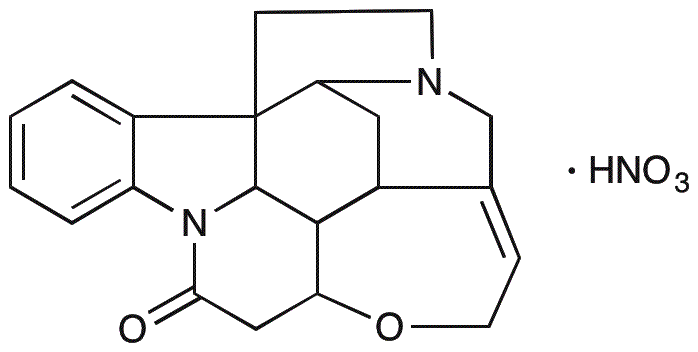Strychnine nitrate is widely utilized in research focused on:
- Toxicology Studies: This compound is often used in toxicology to study its effects on the nervous system, helping researchers understand poisoning mechanisms and develop antidotes.
- Pharmacological Research: It serves as a tool in pharmacology to investigate neurotransmitter systems, particularly in understanding the role of glycine receptors in the central nervous system.
- Biochemical Assays: Strychnine nitrate is employed in various biochemical assays to measure the activity of certain enzymes, providing insights into metabolic pathways.
- Ecological Studies: In environmental research, it is used to assess the impact of toxins on wildlife, aiding in conservation efforts and ecological risk assessments.
- Forensic Science: The compound plays a role in forensic investigations, helping to identify cases of strychnine poisoning in toxicological analyses.
General Information
Properties
Safety and Regulations
Applications
Strychnine nitrate is widely utilized in research focused on:
- Toxicology Studies: This compound is often used in toxicology to study its effects on the nervous system, helping researchers understand poisoning mechanisms and develop antidotes.
- Pharmacological Research: It serves as a tool in pharmacology to investigate neurotransmitter systems, particularly in understanding the role of glycine receptors in the central nervous system.
- Biochemical Assays: Strychnine nitrate is employed in various biochemical assays to measure the activity of certain enzymes, providing insights into metabolic pathways.
- Ecological Studies: In environmental research, it is used to assess the impact of toxins on wildlife, aiding in conservation efforts and ecological risk assessments.
- Forensic Science: The compound plays a role in forensic investigations, helping to identify cases of strychnine poisoning in toxicological analyses.
Documents
Safety Data Sheets (SDS)
The SDS provides comprehensive safety information on handling, storage, and disposal of the product.
Product Specification (PS)
The PS provides a comprehensive breakdown of the product’s properties, including chemical composition, physical state, purity, and storage requirements. It also details acceptable quality ranges and the product's intended applications.
Certificates of Analysis (COA)
Search for Certificates of Analysis (COA) by entering the products Lot Number. Lot and Batch Numbers can be found on a product’s label following the words ‘Lot’ or ‘Batch’.
Numéro de catalogue
Numéro de lot/série
Certificates Of Origin (COO)
This COO confirms the country where the product was manufactured, and also details the materials and components used in it and whether it is derived from natural, synthetic, or other specific sources. This certificate may be required for customs, trade, and regulatory compliance.
Numéro de catalogue
Numéro de lot/série
Safety Data Sheets (SDS)
The SDS provides comprehensive safety information on handling, storage, and disposal of the product.
DownloadProduct Specification (PS)
The PS provides a comprehensive breakdown of the product’s properties, including chemical composition, physical state, purity, and storage requirements. It also details acceptable quality ranges and the product's intended applications.
DownloadCertificates of Analysis (COA)
Search for Certificates of Analysis (COA) by entering the products Lot Number. Lot and Batch Numbers can be found on a product’s label following the words ‘Lot’ or ‘Batch’.
Numéro de catalogue
Numéro de lot/série
Certificates Of Origin (COO)
This COO confirms the country where the product was manufactured, and also details the materials and components used in it and whether it is derived from natural, synthetic, or other specific sources. This certificate may be required for customs, trade, and regulatory compliance.


